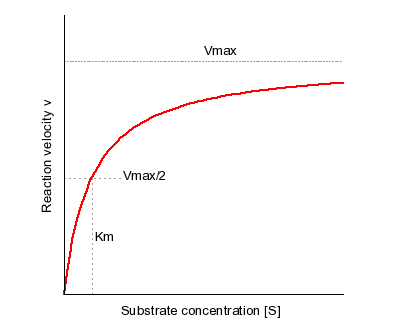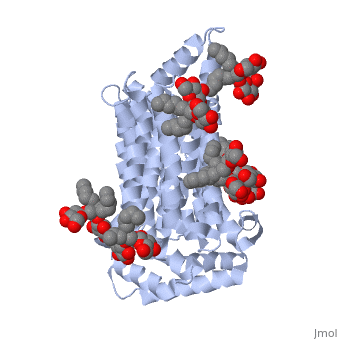From Proteopedia
(Difference between revisions)
proteopedia linkproteopedia link
|
|
| Line 10: |
Line 10: |
| | | | |
| | == Disease == | | == Disease == |
| - | Current research has made insights in to the structure of GLUT3, allowing for investigations into variable expression resulting in association with disease processes. Certain GLUT proteins, such as GLUT1 and GLUT3, has increased expression in cancer cells. Analyzing the variation in expression patterns within this protein has been used as a diagnostic tool, and in certain cases it can be used as an imaging tool in oncology. Lastly, there are currently investigations into the applications of GLUT as a drug delivery mechanism due to its binding and conformation properties. | + | Current research has made insights in to the structure of GLUT3, allowing for investigations into variable expression resulting in association with disease processes. Certain GLUT proteins, such as GLUT1 and GLUT3, has increased expression in cancer cells. The most common and well described change of GLUT expression is in cancer cells that switch their metabolism primarily to glycolysis, which is far less energy-efficient and requires far more substrate. This rapid metabolic change is often referred to as the Warburg effect. Analyzing the variation in expression patterns within this protein has been used as a diagnostic tool, and in certain cases it can be used as an imaging tool in oncology. Lastly, there are currently investigations into the applications of GLUT as a drug delivery mechanism due to its binding and conformation properties. |
| | | | |
| | == Relevance == | | == Relevance == |
Revision as of 20:43, 27 February 2018
| This Sandbox is Reserved from January through July 31, 2018 for use in the course HLSC322: Principles of Genetics and Genomics taught by Genevieve Houston-Ludlam at the University of Maryland, College Park, USA. This reservation includes Sandbox Reserved 1311 through Sandbox Reserved 1430.
|
To get started:
- Click the edit this page tab at the top. Save the page after each step, then edit it again.
- Click the 3D button (when editing, above the wikitext box) to insert Jmol.
- show the Scene authoring tools, create a molecular scene, and save it. Copy the green link into the page.
- Add a description of your scene. Use the buttons above the wikitext box for bold, italics, links, headlines, etc.
More help: Help:Editing
|
Human Glucose Transporter GLUT3/SLC2A3
| Protein 5c65 is part of the protein class GLUT. The GLUT proteins class facilitates the transport of glucose and hexoses over the plasma membrane is highly evolutionarily conserved across phyla. It is important to note that this protein is an isoform of GLUT 1, a protein which mediates equilibrative glucose transport. Specifically, the GLUT3 protein is mostly expressed in neurons, where it is believed to be the primary glucose transporter. In certain cases, it is expressed to facilitate glucose transport in the placenta. This protein was isolated from human liver cDNA libraries.
Function
The primary biological function of this protein is for glucose transmembrane transport, or the transport of glucose molecules over the plasma membrane. Using the Michaelis-Mentin Kinetics Model, the GLUT3 mediated transport of glucose had a higher affinity during the outward substrate binding site. Secondly, the transport occurs more efficiently and quickly when the substrate is present on the trans site of the membrane.

Disease
Current research has made insights in to the structure of GLUT3, allowing for investigations into variable expression resulting in association with disease processes. Certain GLUT proteins, such as GLUT1 and GLUT3, has increased expression in cancer cells. The most common and well described change of GLUT expression is in cancer cells that switch their metabolism primarily to glycolysis, which is far less energy-efficient and requires far more substrate. This rapid metabolic change is often referred to as the Warburg effect. Analyzing the variation in expression patterns within this protein has been used as a diagnostic tool, and in certain cases it can be used as an imaging tool in oncology. Lastly, there are currently investigations into the applications of GLUT as a drug delivery mechanism due to its binding and conformation properties.
Relevance
Both the amino and carbonyl termini of the protein are exposed on the cytoplasmic side of the plasma membrane. This protein functions via the alternative confirmation model. A transport protein exposes a substrate towards either the outside or inside the cell. When the glucose or hexose binds to the site, it catalyzes a conformational change, releasing the glucose on the other side of the membrane. GLUT3 is a unique glucose transporter in that it functions even in times of low glucose.
Structural highlights
The protein contains and has no known post-translational modifications. The first 6 transmembrane helices are in a pseudo symmetrical configuration relative to the last 6 helices. Helices 1, 2, 4, 5, 7, 8, 10, and 11 form an inner bundle that is stabilized by the outer helices 3, 6, 9, and 12. The GLUT3 protein is comprised of ~500 amino acid residues. It has a single site for N-Linked glycosylation, a central cytoplasmic linker domain, and exhibit topologies with their N and C termini, which are both positioned in the cytoplasm.
The protein also contains nine . The molecule itself is octyl glucose neopentyl glycol, which is part of a class of surfactants called glucose-neopentyl glycol (GNG) amphiphiles. GNG amphiphiles are very useful for solubilization and stabilization of membranes
The protein has another kind of ligand, . This molecule is cholesterol hemisuccinate, which is a membrane stabilizer. This is important for the function of GLUT3 as it transports glucose across the plasma membranes.
|
References
Carruthers, A., DeZutter, J., Ganguly, A., & Devaskar, S. U. (2009, October). Will the original glucose transporter isoform please stand up! Retrieved February 27, 2018, from https://www.ncbi.nlm.nih.gov/pubmed/19690067
Chae, P. S., Rana, R. R., Gotfryd, K., Rasmussen, S. G., Kruse, A. C., Cho, K. H., . . . Gellman, S. H. (2013, March 21). Glucose-Neopentyl Glycol (GNG) Amphiphiles for Membrane Protein Solubilization, Stabilization and Crystallization. Retrieved February 27, 2018, from https://www.ncbi.nlm.nih.gov/pmc/articles/PMC3578972/
Cheeseman, C., & Long, W. (2015). Structure of, and functional insight into the GLUT family of membrane transporters. Cell Health and Cytoskeleton, 167. doi:10.2147/chc.s60484
Ding, W. X., Qi, X. R., Li, P., Maitani, Y., & Nagai, T. (2005, August 26). Cholesteryl hemisuccinate as a membrane stabilizer in dipalmitoylphosphatidylcholine liposomes containing saikosaponin-d. Retrieved February 27, 2018, from https://www.ncbi.nlm.nih.gov/pubmed/15978754
Mueckler, M., & Thorens, B. (2013). Retrieved February 27, 2018, from https://www.ncbi.nlm.nih.gov/pmc/articles/PMC4104978/
Potaman, V. N. (1970, January 01). DNA: Alternative Conformations and Biology. Retrieved February 27, 2018, from https://www.ncbi.nlm.nih.gov/books/NBK6545/


